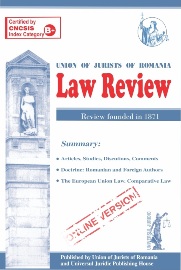THE TWISTED TALE OF THE COMPATIBILITY OF AN ISDS CLAUSE ESTABLISHED BY AN INTRA-EU BIT WITH THE EU LAW: A SCRUTINY OF THE ADVOCATE GENERAL WATHELET’S OPINION IN THE ACHMEA CASE
THE TWISTED TALE OF THE COMPATIBILITY OF AN ISDS CLAUSE ESTABLISHED BY AN INTRA-EU BIT WITH THE EU LAW: A SCRUTINY OF THE ADVOCATE GENERAL WATHELET’S OPINION IN THE ACHMEA CASE
Author(s): Anamaria Toma-BianovSubject(s): Law, Constitution, Jurisprudence, Civil Law, Public Law, EU-Legislation
Published by: Universul Juridic
Keywords: Public Law; European Union Law; Investment Treaty Arbitration under intra-EU BITs;
Summary/Abstract: Once a precondition for a successful accession to European Union for the countries of Eastern Bloc, the bilateral investment treaties concluded in the pre-accession period (currently, the “intra-EUBITs”) became a “systemic risk” for the very legal order that encouraged their extension. The turning point from construction engagements to deconstruction remains imprecise in time and incomprehensible in its attempts, as the hegemony of EU law does not entirely supplement the level of investment protection afforded by intra-EU BITs. Undeniably, the EU Treaties and the intra-EU BITs do not offer the same standards of investment protection and do not provide for equivalent remedies, despite the European Commission’s efforts to make us believe the contrary. Free movement of capital, freedom of establishing and the EU Charter of Fundamental Rights set out by EU law do not duplicate the guarantees that commonly enter the scope of an intra-EU BIT, such as full protection and security of investments (FPS), the fair and equitable treatment of investments (FET) and the prohibition of illegal expropriations. Moreover, a number of provisions that are likely to be incorporated in an intra-EU BIT, including most favored nation (MFN) clause, the umbrella clause, the sunset clause and the investor state dispute settlement (ISDS) clause, have no equivalent in EU law. In light of this argument, it is difficult to understand the policy of intra-EU BITs eradication without a proper, mutually-consented and effective reform of intra-EU investment system. Undoubtedly, the European Commission’s crusade against the intra-EU BITs was initiated in order to prevent the cross-border EU investors to resort to an outside dispute settlement mechanism. In the European Commission’s view, the reliance on investment treaty arbitration reveals the mistrust in the courts of EU Member States and puts at risk both the principle of mutual trust in the administration of justice in European Union and the supremacy of EU law. Nevertheless, the arbitral mechanism is presently under the scrutiny of the Court of Justice of European Union (CJ), which is called to rule on the compatibility of an ISDS clause with the EU law. The ruling in Achmea will definitely bring the light into the blurred context of the intra-EU investments and will vanish the legal uncertainty intra-EU investors are exposed to. But until that particular moment in time, a special attention should be given to the Opinion of the Advocate General Wathelet, delivered on 19 September 2017. The Opinion is not of tremendous importance for its final findings, as the CJ is not bound to follow it, but for its far-reaching and extremely lucid preliminary observations. Whether the ISDS clause established by an intra-EU BIT will be validated in the European Union legal order, as prompted by AG Wathelet, remains a matter open to debate for the time being. Notwithstanding the importance of such a debate, it will be more interesting to find out an answer to the yet rhetorical question of AG Wathelet: “[h]owever, if those BITs were justified only during the association period and each party was aware that they would become incompatible with the EU and FEU Treaties as soon as the third State concerned had become a member of the Union, why did the accession treaties not provide for the termination of those agreements, thus leaving them in uncertainty which has lasted more than 30 years in the case of some Member States and 13 years in the case of many others?”.
Journal: Law Review
- Issue Year: 2017
- Issue No: 02
- Page Range: 3-23
- Page Count: 21
- Language: English
- Content File-PDF

